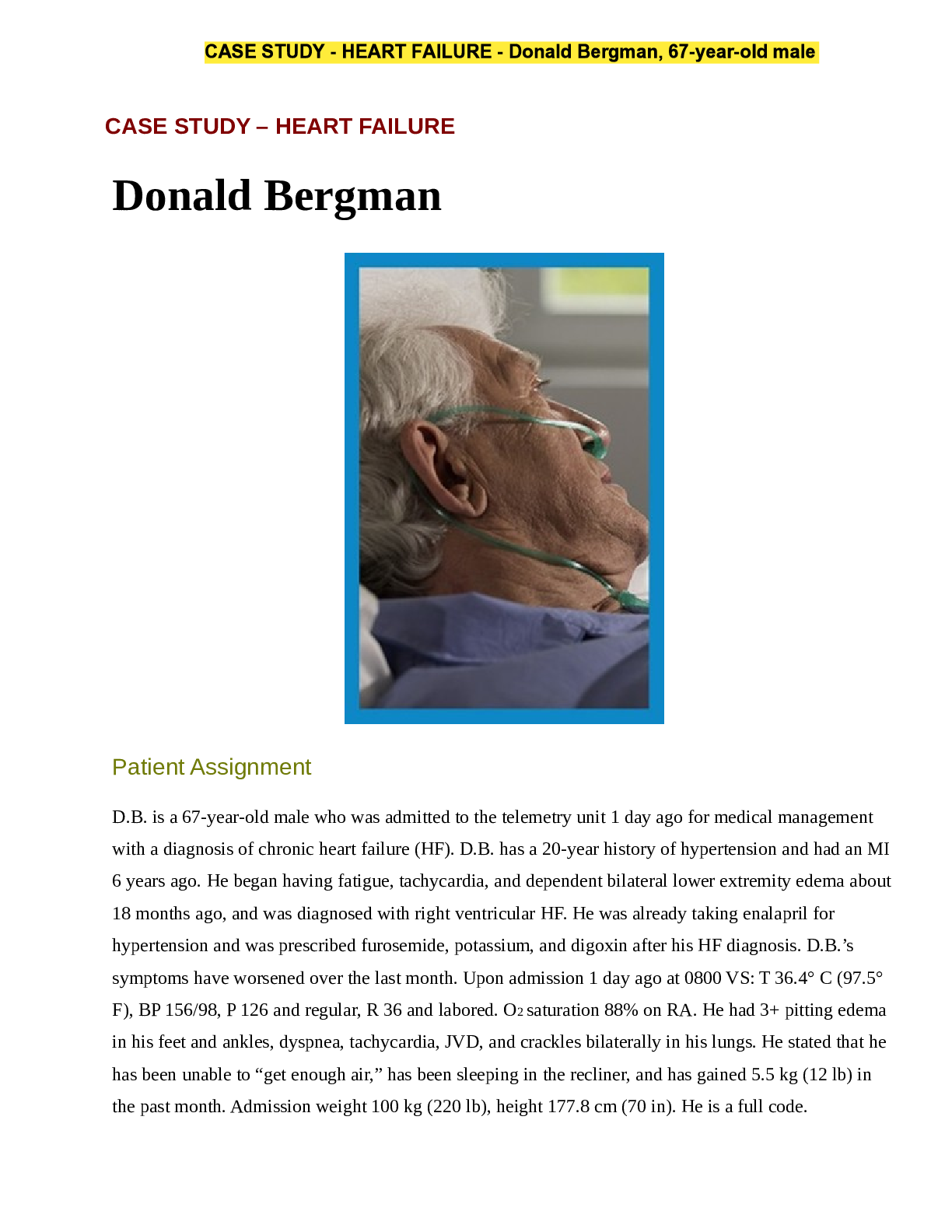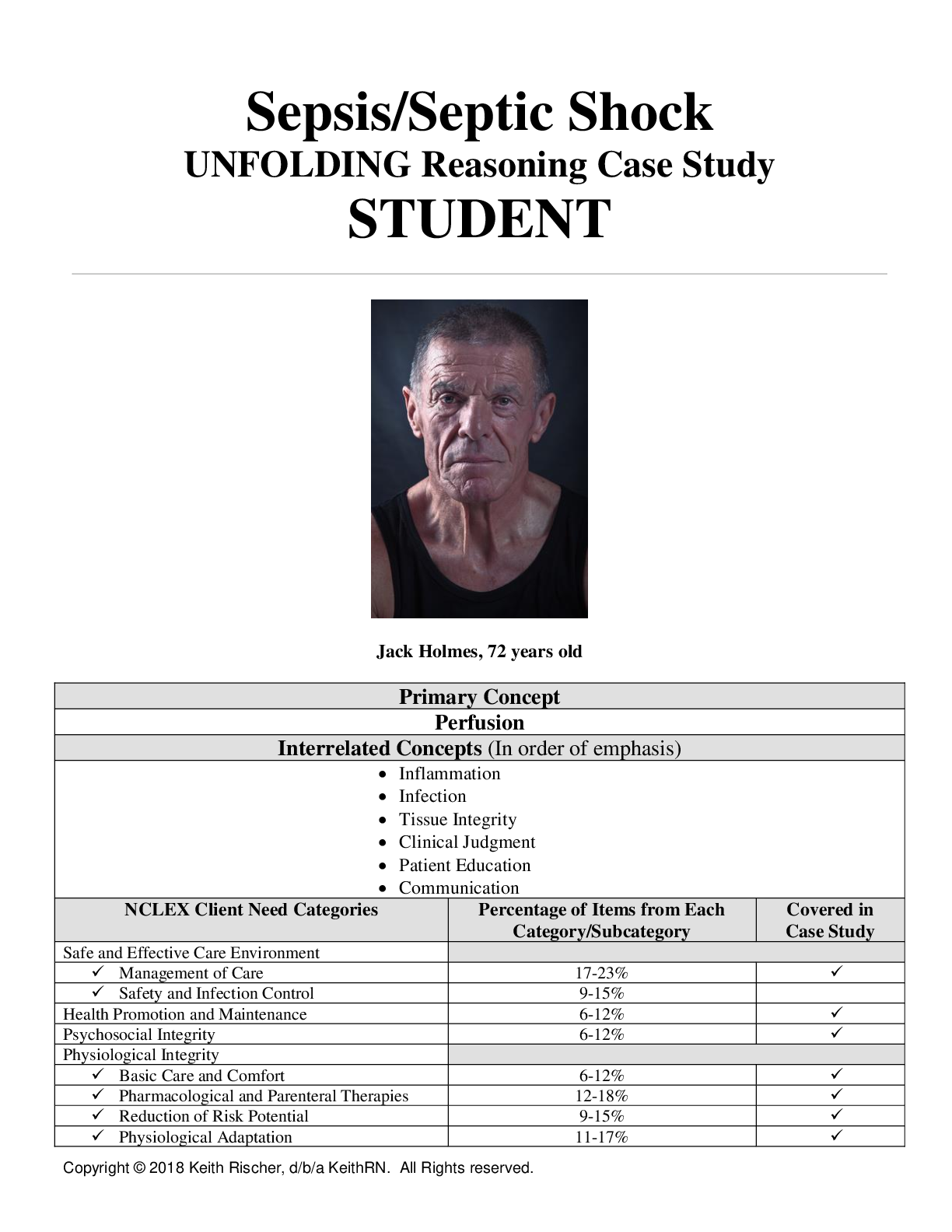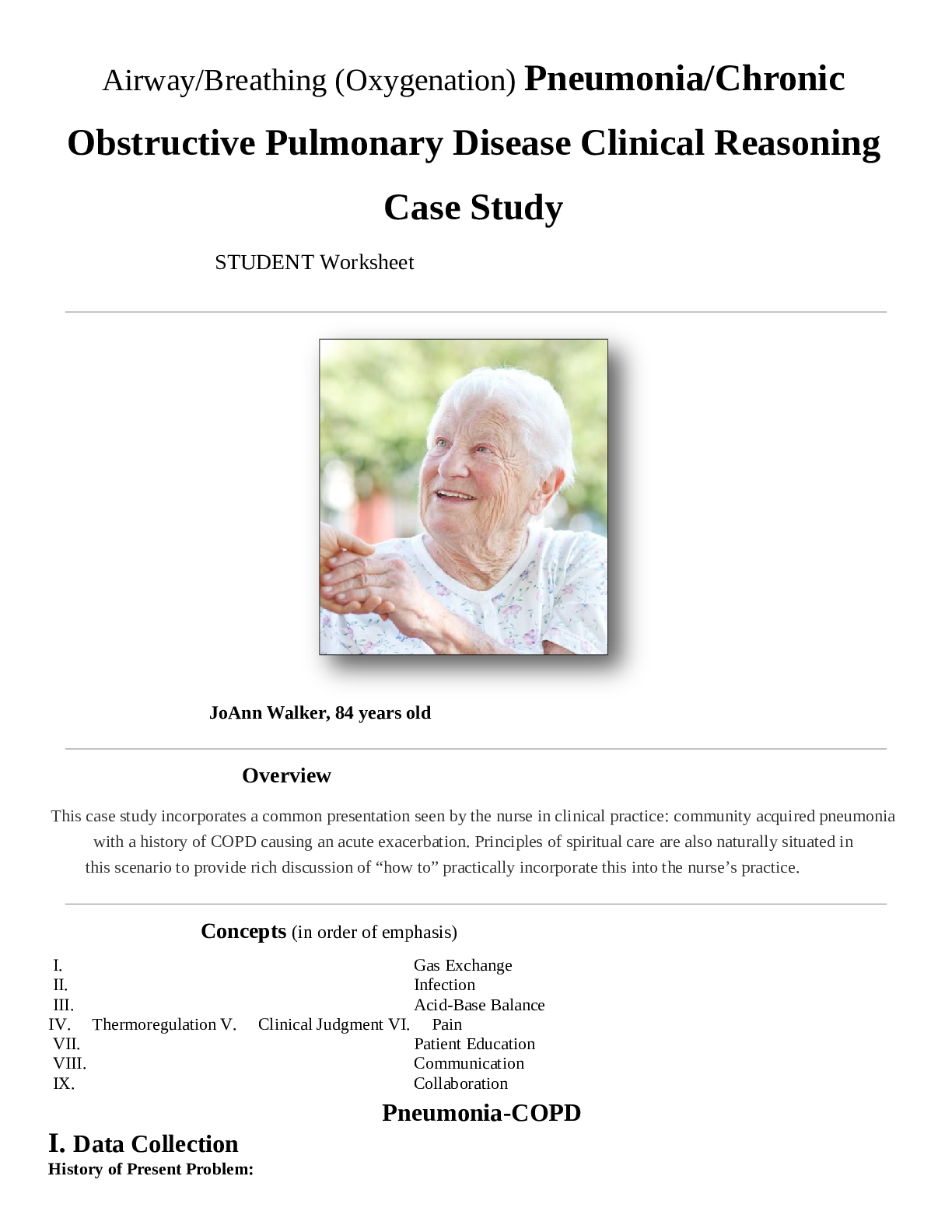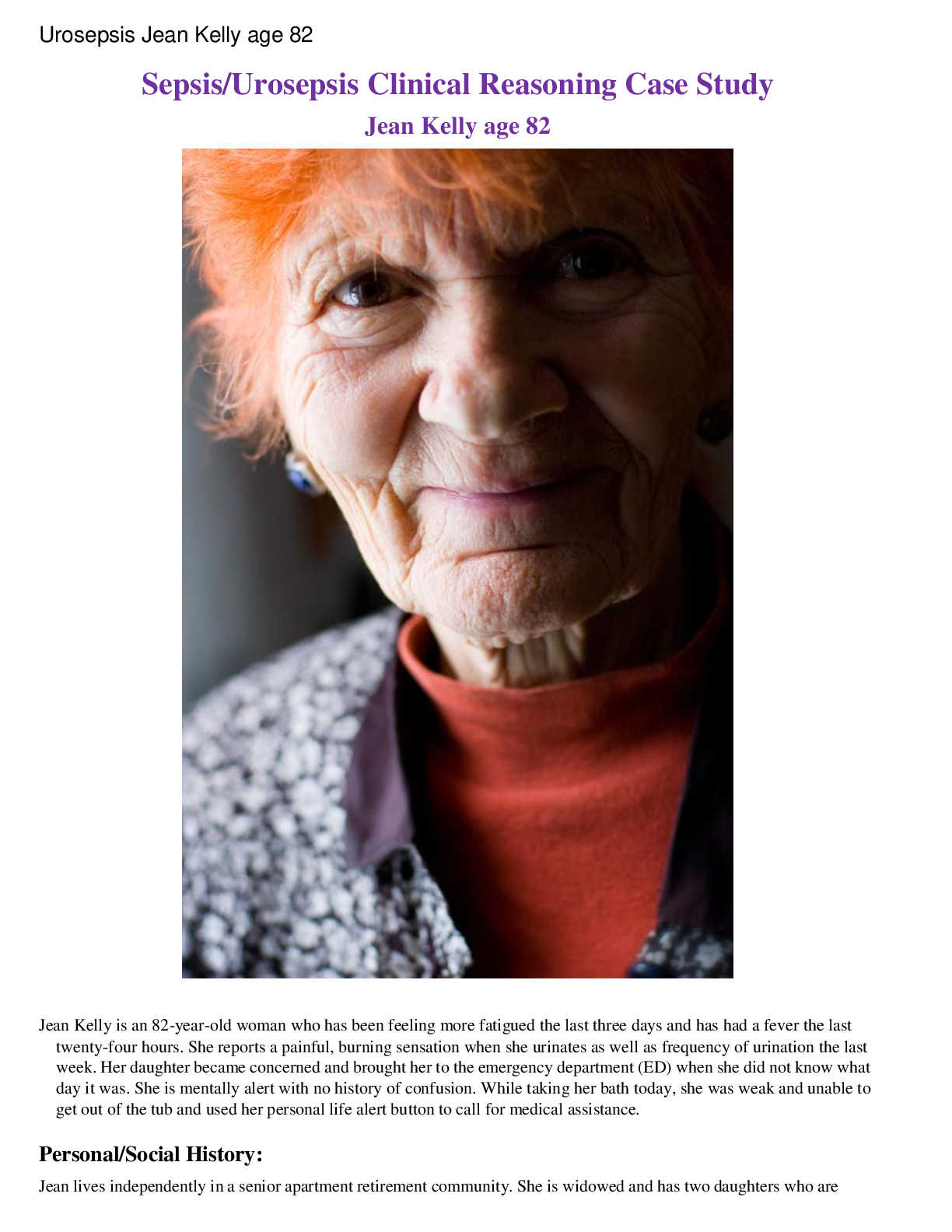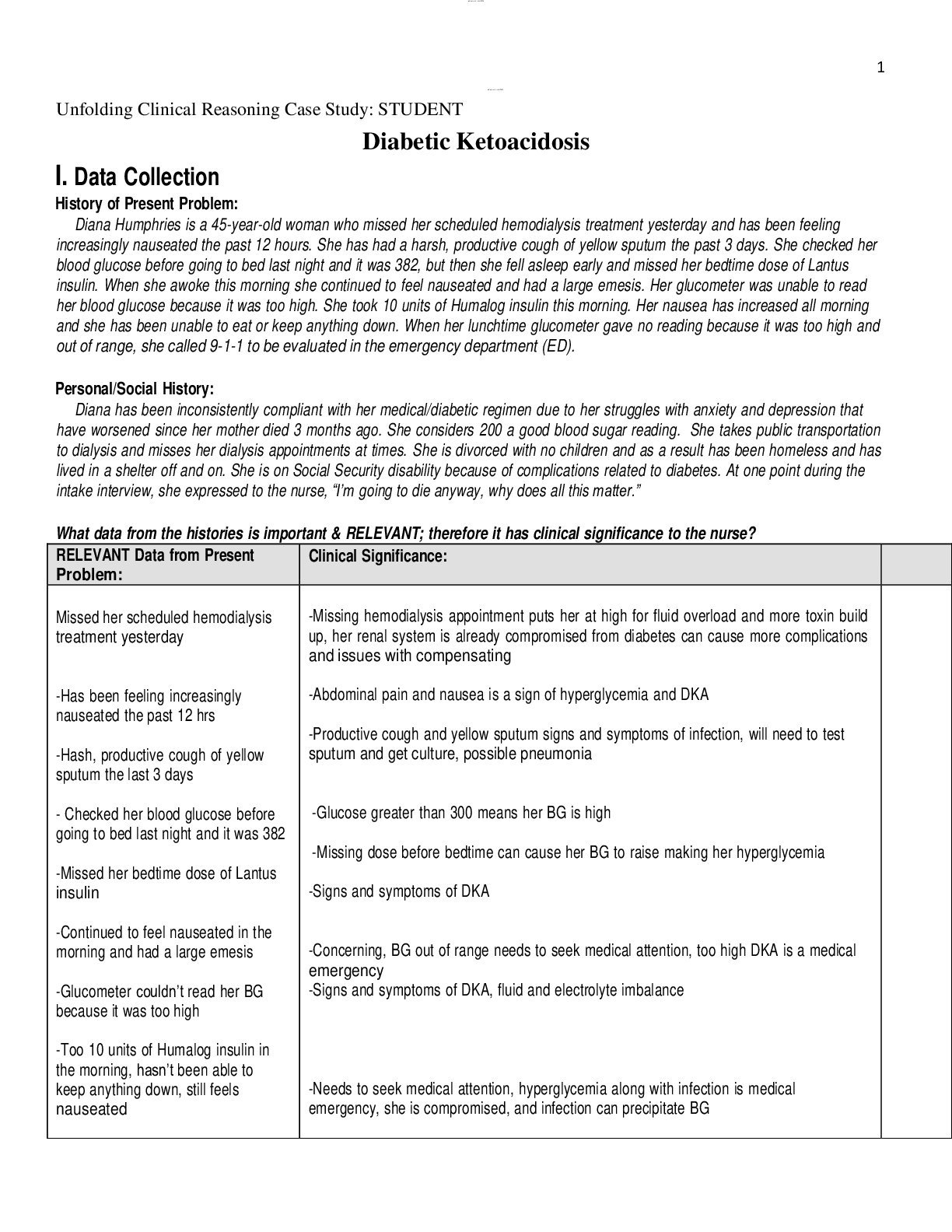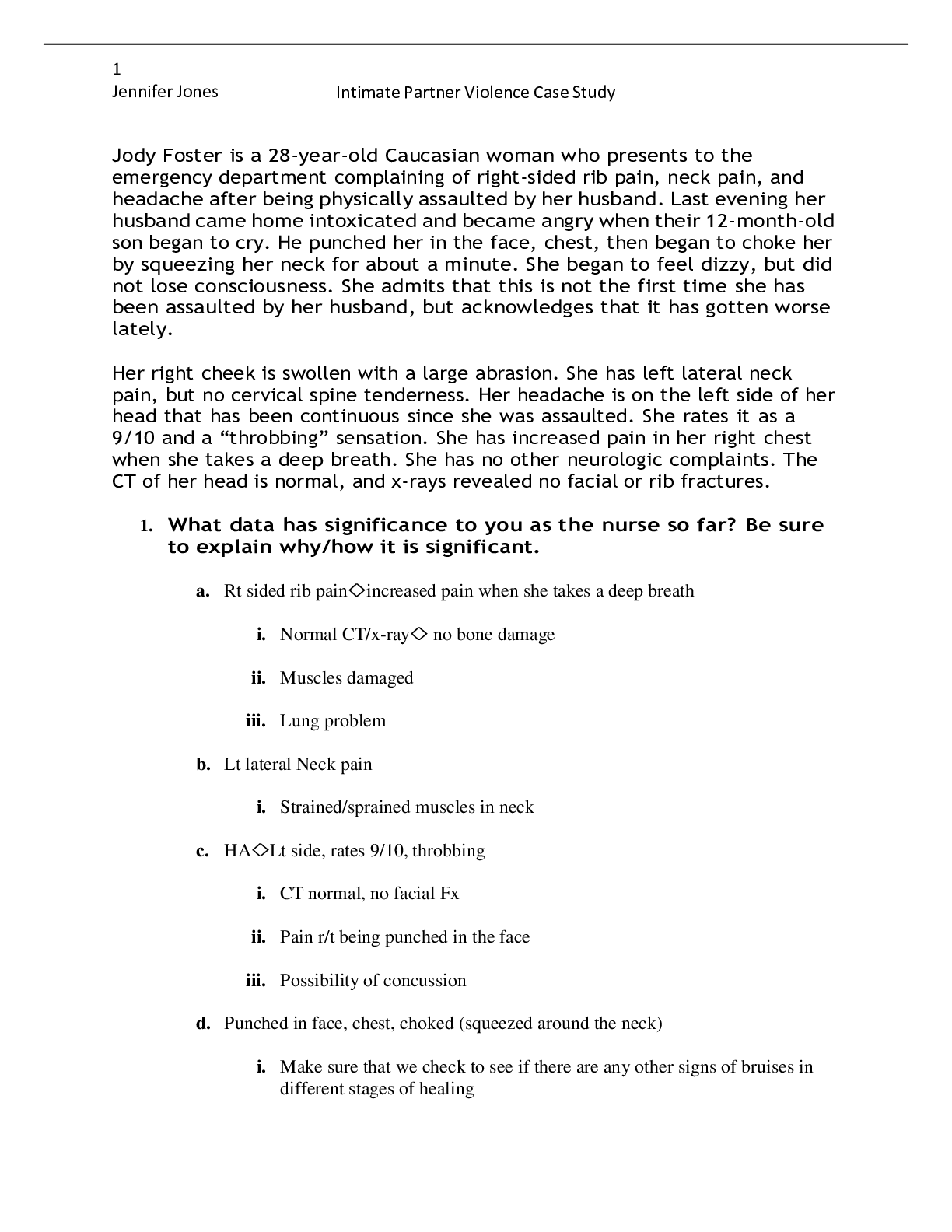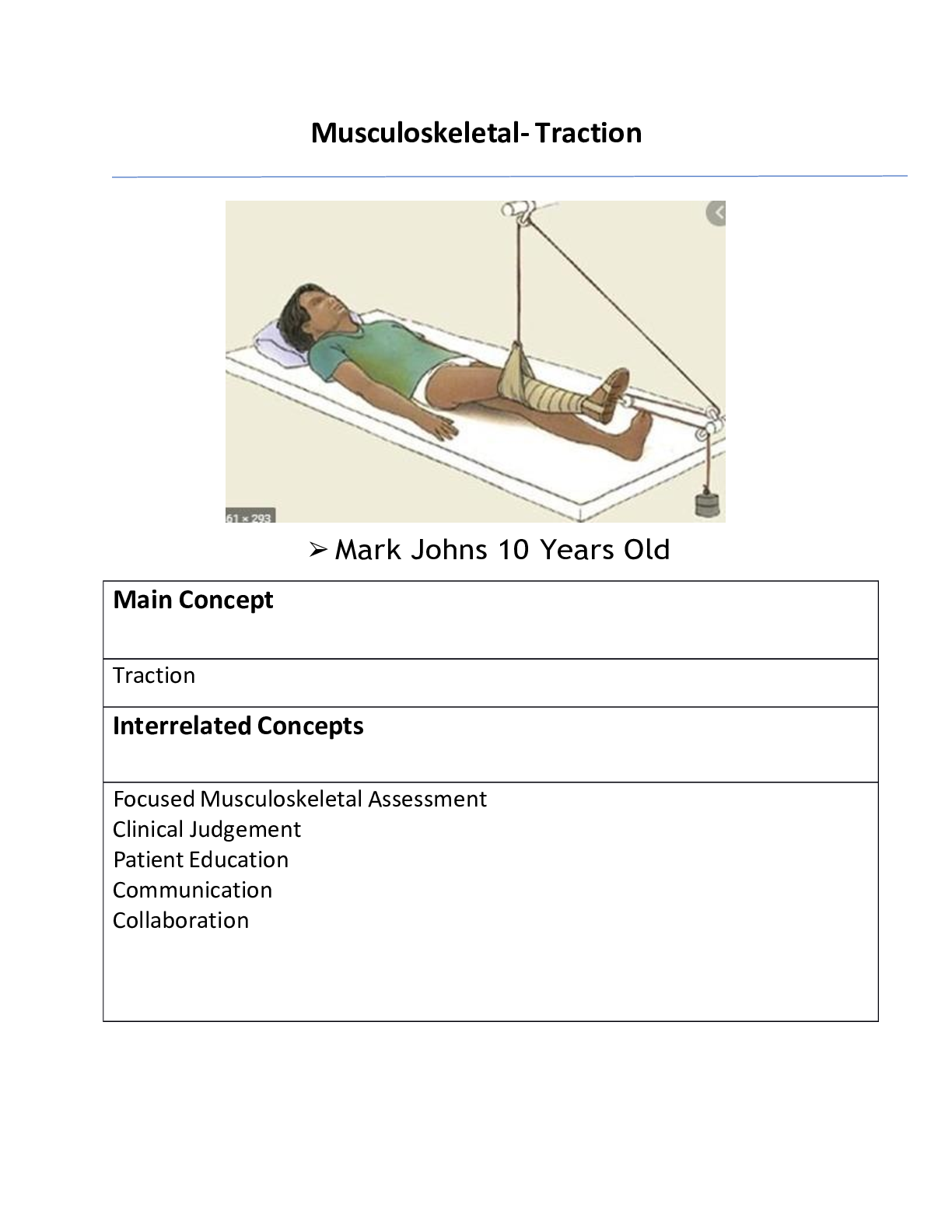*NURSING > CASE STUDY > Caulder NUR 112 Legal Issues Case Study Student (All)
Caulder NUR 112 Legal Issues Case Study Student
Document Content and Description Below
Legal Issues Case Study (1) You are in your final clinical rotations of nursing school. The clinical instructor assigns each student to two patients. Although you accept your assignment, you feel une... asy about providing care for two patients, especially since both have congestive heart failure. You are extremely cautious as you check the prescribed medications in your reference book, check each patient's name band, check the medications with the staff nurse, and administer the doses. To save time, you take both patients' medications into the room at the same time. You document every nursing action, including the education on medications given to patients. When the instructor asks how things are going, you feel confident in stating that you are handling two patients very well. You further explain how you took the initiative to educate one of your patients on the side effects of a new blood pressure pill when the patient stated he never took the medication before. The instructor asks to see the order for the drug, but when you look for the physician's order, you are unable to find it! You suddenly realize that you switched the patients' medications and wrongly dosed both patients. Later in the shift, one patient's blood pressure drops to the point of requiring a transfer to ICU and the other goes into renal failure, requiring dialysis. 1. Who is liable for the actions of the student nurse—you (because you gave the medications), the staff nurse (who checked the medications), or the instructor (who was supervising)? 2. Did the instructor meet the standards for supervisory liability? 3. Suppose you had requested supervision for the medication administration but could not find your instructor. Who would be liable in this case and why? . Legal Issues Case Study (2) A student is doing a clinical rotation on a medical-surgical unit. In the hallway outside a patient's room, a staff nurse explains the patient's diagnosis to the student, mentioning that the medical condition typically is seen in patients with long-term cocaine use. When providing care for the patient, the student asks about any illegal drug use. The patient becomes upset and says that he has never used illegal drugs in his life. The student tells the patient that his condition is usually seen with long-term cocaine use. The patient orders the student out of his room, yelling that she has violated his constitutional rights and he is going to sue her for not providing a reasonable standard of care. 1. Did a breach of confidentiality occur between the student and the patient or between the student and the nurse? Explain. 2. Was a constitutional law broken in this scenario? 3. Was the interaction between the nurse and the student appropriate? Did it violate any laws? 4. Would the patient in this scenario have grounds for malpractice? Legal Issues Case Study (3) Britney is a nurse on the orthopedic unit at a local hospital. She agrees to cover for Paul, another nurse on the unit, during his lunch break. The nursing assistant tells Britney that one of Paul's patients, a 62-year-old female 2 days postoperative for a hip replacement, is complaining of pain in the hip. Britney reviews the medication sheets, finding an order for 50 mg of Demerol every 4-6 hours IM or IV push. She notes that the patient received Vicodin 10 mg 3 hours ago with no pain relief. Britney decides to give the Demerol intravenously for better control of the pain. She administers the medication, and 15 minutes later the patient is unable to breathe because of swelling of her throat. The patient is transferred to the intensive care unit and makes a full recovery. Britney reviews the chart, which documents the patient's allergy to Demerol. The patient had not received the medication during the hospital stay until it was given by Britney. 1. Who has the duty to provide reasonable care in this scenario? Does Paul retain accountability? Did Britney assume accountability? 2. Was there a process problem leading to the problem? 3. How does professional duty apply in this scenario? 4. How would a breach of professional duty be proved in this scenario? Explore intentional versus unintentional breaches. 5. What damages might the plaintiff claim as a result of the action? 6. Which type of liability might apply in this scenario? 7. The hospital did not pursue any punitive measures against Britney nor Paul. What is the rationale for this action? Legal Issues Case Study (4) Karen is a nurse with 10 years of experience on an orthopedic unit. She prides herself on providing excellent patient care. Today, Karen's patient is a 72-year-old male who is 5 days postoperative for a total knee replacement. The patient has been working with physical therapy twice a day and is progressing towards discharge. His activity order is up ad lib (up as tolerated per self). Karen sets up his breakfast tray, puts nonskid slippers on his feet, and assists him to the chair to eat. She tells the patient, "I'll be back shortly, but if you need anything, call and I'll come right back." She places the call light next to the patient's chair and leaves the room. A short time later, Karen hears a loud thump coming from the patient's room. She finds him on the floor, confused and wet with urine. She helps him back to bed with the assistance of two nursing aides and performs an assessment, noting that the confusion is new. Karen reports the fall to the physician, who gives her orders for a knee x-ray. 1. Were Karen's actions appropriate in this scenario? Could anything else have been done? 2. Karen's facility has a fall protocol that requires documentation for the risk level of the patient. Karen's patient was in the low-risk category, requiring nonskid slippers, personal items within reach, and a room free of hazards. Since Karen did not place the urinal within the patient's reach, was she negligent by not following the fall protocol? Does this make her more likely to be found liable? 3. Karen's documentation shows that the patient was found on the floor, that he didn't remember how he fell, that she notified the physician, and that a knee x-ray was ordered. Is Karen's documentation complete? 4. Karen is charged with failing to adequately assess, monitor, and obtain assistance by the hospital. How do these charges apply to Karen's situation? How could she have prevented them? Legal Issues Case Study (5) You are providing care for a patient who is scheduled for an angioplasty. The physician orders include obtaining an informed consent for a "coronary intervention." 1. Do you feel comfortable having the patient sign an informed consent for a "coronary intervention?" Why or why not? 2. What duty do you owe to the patient when obtaining the informed consent? 3. If the patient tells you that he or she has not talked to the physician about the procedure would you still obtain an informed consent? Legal Issues Case Study (6) While you are at your son's baseball game, one of the other players slides into second base and then lies there without moving. Another player yells for help. The other parents know you are a nurse and ask you to check on the player while they call 911. When you approach the child, you note that his leg is fractured and lying in an awkward position. You feel that if you reposition the leg, you might cause more harm and pain for the child. You assess the leg and note it is warm with a palpable pedal pulse. You provide care to ensure he does not go into shock until the ambulance arrives. The child's parents are called and will meet the ambulance at the emergency department. Three months after the incident you receive word that you are being sued for malpractice because you did not provide interventions to ensure the safety of the leg. The child is undergoing extensive physical therapy related to neuromuscular damage to his leg. 1. Does this scenario meet the basic elements of malpractice? Explain 2. If you were working or volunteering at a first aid station and this scenario occurred, would the basic elements of malpractice apply? Why or why not? 3. If you are the first aid nurse in this scenario, what specific actions should you take immediately following the accident? How could this protect you from a possible lawsuit? [Show More]
Last updated: 1 year ago
Preview 1 out of 9 pages

Buy this document to get the full access instantly
Instant Download Access after purchase
Add to cartInstant download
We Accept:

Reviews( 0 )
$12.00
Document information
Connected school, study & course
About the document
Uploaded On
Apr 21, 2021
Number of pages
9
Written in
Additional information
This document has been written for:
Uploaded
Apr 21, 2021
Downloads
0
Views
42

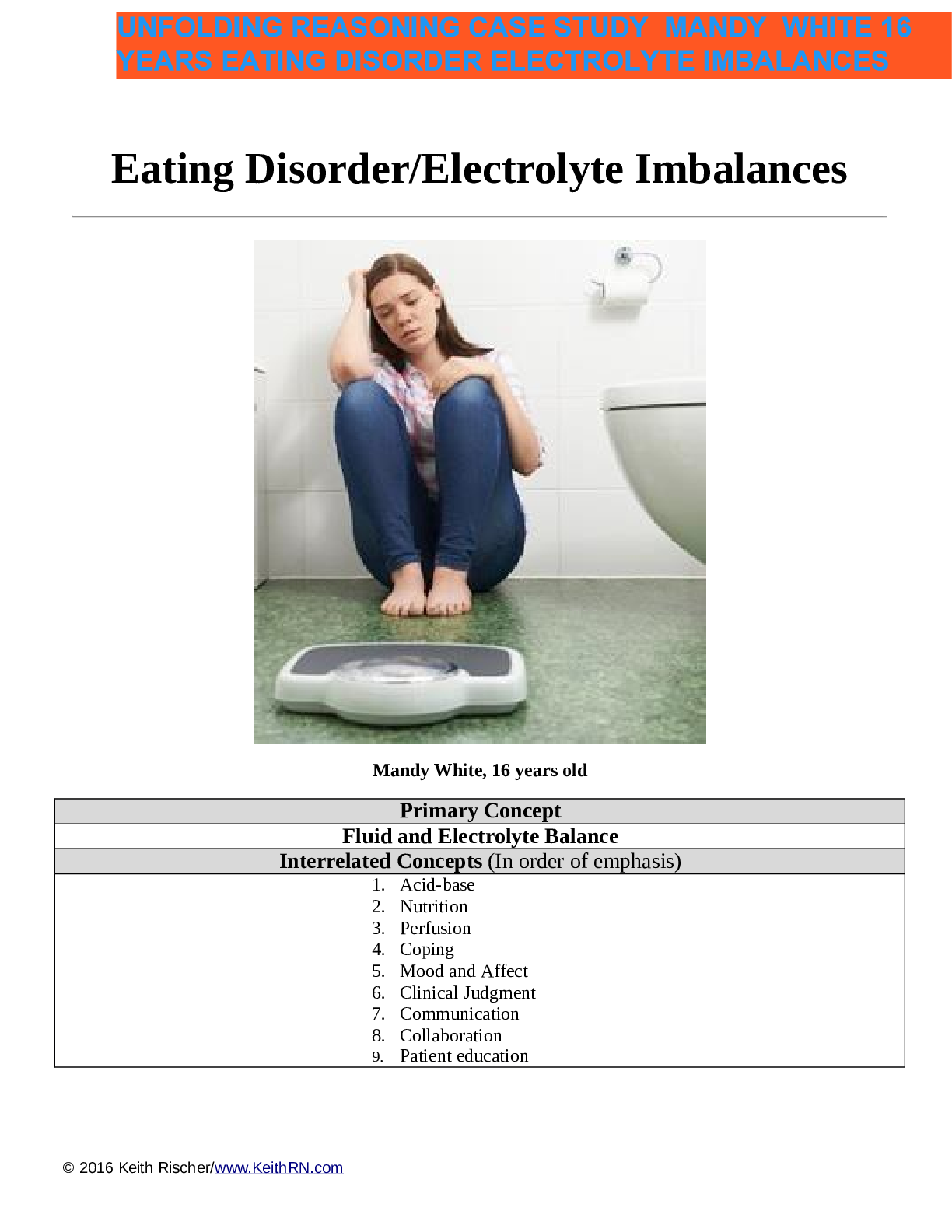
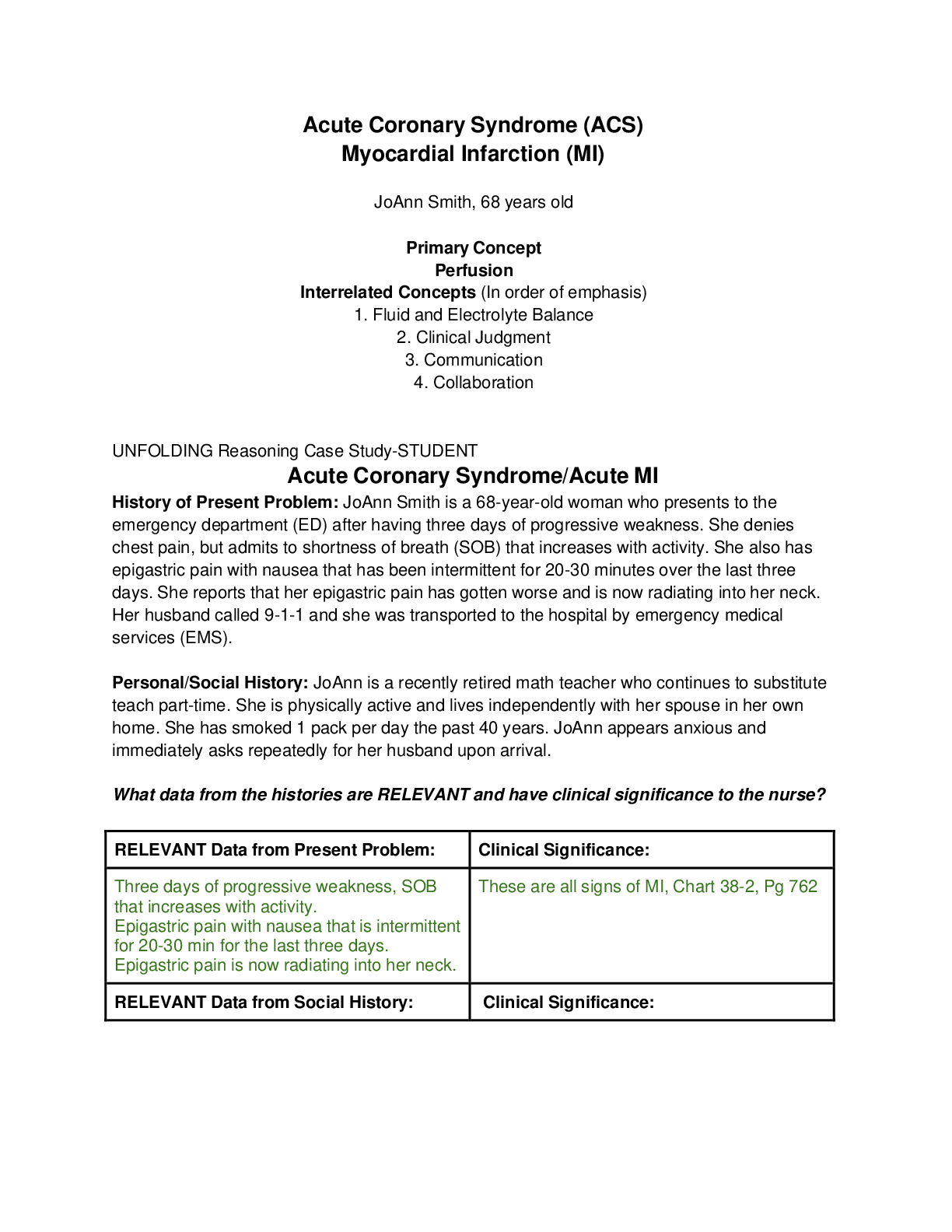
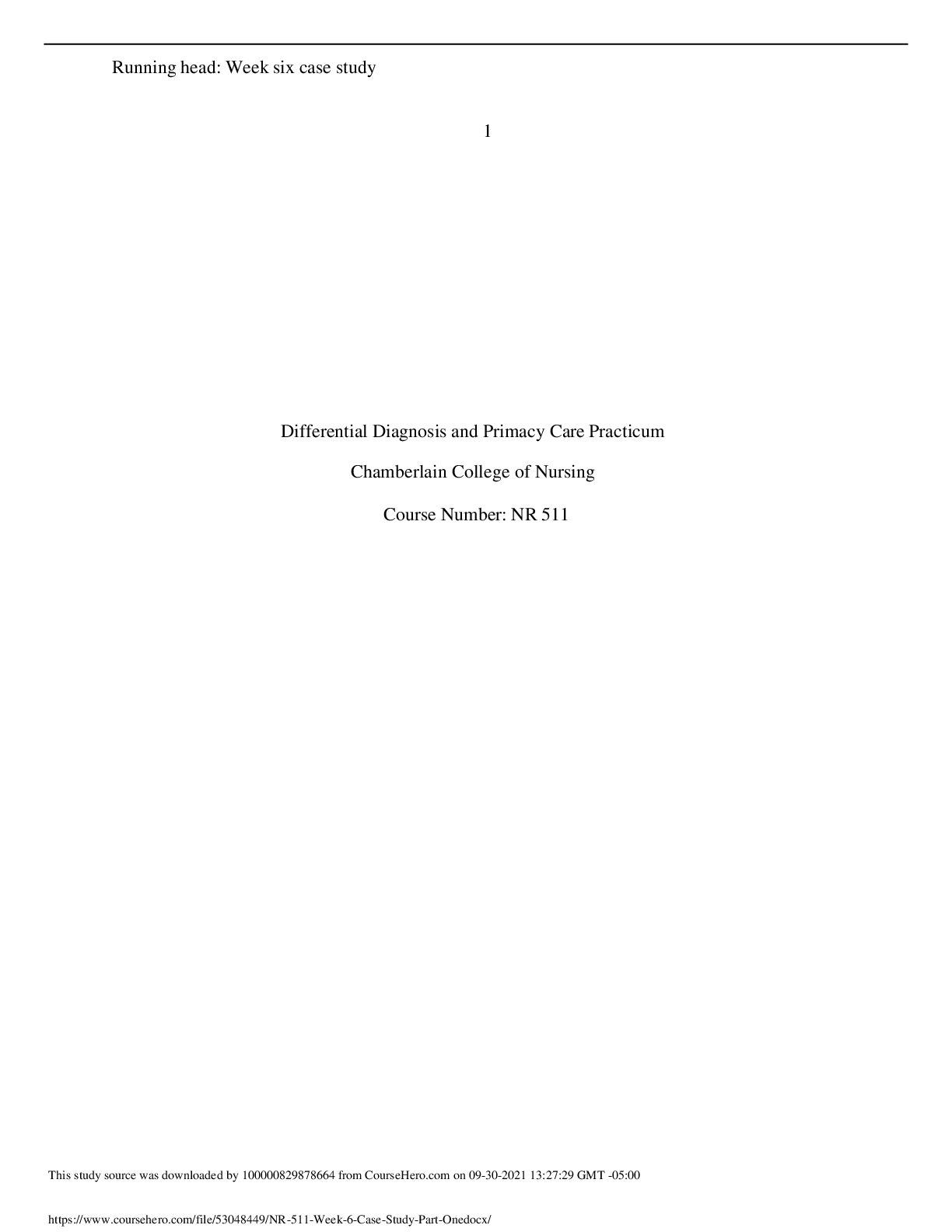

 (1).png)
